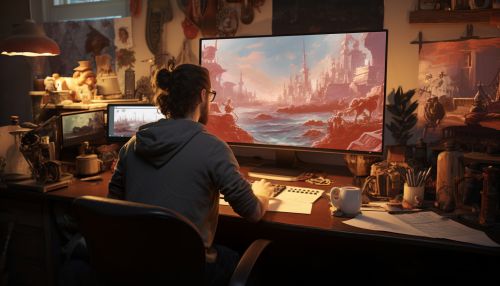Game Design
Overview
Game design is the art of applying design and aesthetics to create a game for entertainment or for educational, exercise, or experimental purposes. Increasingly, elements and principles of game design are also applied to other interactions, particularly virtual ones (see Gamification).
History
The history of game design dates back to the prehistoric era, where games were often used as a means of survival training. The evolution of game design has been marked by different platforms and devices, with each new generation of technology offering new ways to play and create games.
Principles of Game Design
The principles of game design are the aspects that a game designer considers and manipulates when designing a game. The goal of game design is to create an experience for the player. This includes aspects such as theme, mechanics, and the balance between them.
Theme
The theme of a game is its unifying subject matter or narrative context. In many games, the theme is an essential part of the player's experience. The theme can be as broad as a general genre (like fantasy or war) or as specific as a particular story or scenario.
Mechanics
Mechanics are the rules and procedures that guide the player and the game response to the player's moves or actions. Through the manipulation of game mechanics, designers can shape the narrative and gameplay experience, creating a specific set of interactions and challenges in the game.
Game Design Process
The game design process is a multi-step process that involves conceptualization, design, testing, and refinement. Each step in the process is crucial to the overall success of the game.
Conceptualization
Conceptualization is the initial stage of the game design process. This is where the basic idea for the game is developed. This includes determining the game's theme, setting, characters, and basic gameplay mechanics.
Design
The design phase involves fleshing out the details of the game. This includes creating detailed designs for the game's characters, environments, and gameplay mechanics. This phase also involves creating the game's story and writing any necessary dialogue.
Testing
Testing is a critical part of the game design process. This is where the game is tested to ensure that it is fun to play, that the mechanics work as intended, and that there are no bugs or glitches that could disrupt the player's experience.
Refinement
The refinement phase involves making adjustments and improvements to the game based on feedback from testing. This can include making changes to the game's mechanics, adjusting the difficulty level, or polishing the game's visuals and sound.
Types of Game Design
There are several types of game design, each with its own unique approach and focus. These include video game design, board game design, and tabletop RPG design.
Video Game Design
Video game design involves creating interactive games for platforms such as computers, consoles, and mobile devices. This type of design often involves a team of designers working together, including game mechanics designers, level designers, and narrative designers.
Board Game Design
Board game design involves creating games that are played on a physical board with pieces or cards. This type of design requires a strong understanding of game mechanics and player interaction, as well as the ability to create engaging and balanced gameplay.
Tabletop RPG Design
Tabletop RPG design involves creating games that are played in person with a group of players, typically using pen and paper. This type of design requires a strong understanding of narrative design, as well as the ability to create engaging and immersive worlds for players to explore.
Impact of Game Design
Game design has a significant impact on the player's experience. A well-designed game can provide an engaging, immersive experience that players enjoy. Conversely, a poorly designed game can lead to frustration and a lack of interest.
See Also


